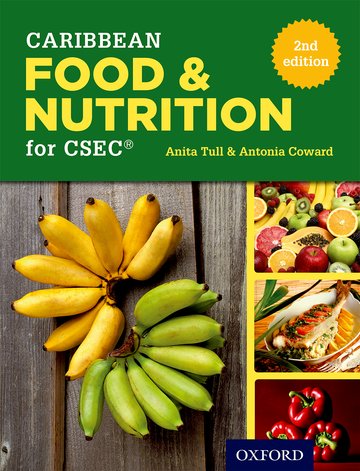Caribbean Food and Nutrition for CSEC
Equip students with the knowledge and skills to achieve
Author Anita Tull and Author Antonia Coward
Suitable for: 14-16, those studying for CSEC Food and Nutrition qualification
Price: £23.99
ISBN:
978-0-19-837471-8
Publication date:
21/04/2016
Paperback:
344 pages
Dimensions:
255x195mm
Availability: In stock.
You can use the basket to:
- pay by credit card
- order on account
- forward to a colleague
Description
Features
- Full syllabus coverage including background information
- Accessible design with images, photographs and examples from across the Caribbean
- Clear and concise content to help students thoroughly understand this subject
- Practical activities and revision questions to help students achieve the highest grade
- Updated content with statistics from various Caribbean countries
This page was last updated on 22 December 2024 at 20:30 GMT
Table of Contents
1 Nutrition
Diet and health
The nutrients
Protein
Fat
Carbohydrate
Food tests
Vitamins
Fat-soluble vitamins
Water-soluble vitamins
Mineral elements
Water
Dietary fibre (NSP)
Energy
Digestion and absorption
The nutrient content of foods
2 Nutritional status, diet, and health
ABCDs of nutritional assessment
Dietary guidelines
Factors that influence food habits and choice of food
Nutritional disorders related to food deficiency
Nutritional diseases related to lifestyle choice
Role of physical activity in maintaining health
Food security
Preventing poor health
Questions and activities
3 Providing food for different needs
Meal planning
Pregnant and lactating women
Nutritional requirements of an infant (up to one year)
Toddlers and young children
School-age children
Adolescents
Adults
People living on low incomes
Older adults
Illness and convalescence
HIV/AIDS
Vegetarians
Religious groups
Food intolerance
Modifying meals to prevent nutritional disorders
Questions and activities
4 Foods and food science
Food systems
Biotechnology
Functional foods or nutraceuticals
Cereals
Fats and oils
Sugar and sweeteners
Milk
Cream
Cheese
Yoghurt
Eggs
Meat
Fish
Alternative protein foods
Gelatine
Vegetables
Legumes, pulses, and nuts
Fruits
Herbs
Spices
Food additives
Convenience foods
Fast food
Food packaging
Questions and activities
5 Practical food preparation
Principles behind the cooking of food
Food spoilage
Preservation of food
Home preservation of fruit
Choosing, preparing, and cooking food
Methods of cooking
Moist methods of cooking
Dry methods of cooking
Frying
Microwave cookery
Freezer cookery
Use of left-over foods
Raising agents
Cakes
Pastries
Yeast mixtures
Batters
Sauces
Salads
Soups and stocks
Summary of changes in food during preparation
Summary of changes in food during cooking
Food presentation
Food preparation for assignments, investigations, and examinations
Commercial restaurants
Questions and activities
6 The kitchen
Kitchen planning
Materials used at home
Cookers
Refrigerators
Kitchen equipment
Consumer protection
Kitchen safety
Questions and activities
Weights
Liquid measures
Oven temperatures
Index
© 2024 Oxford University Press. All rights reserved.





